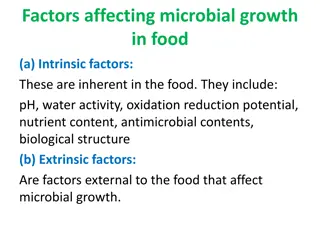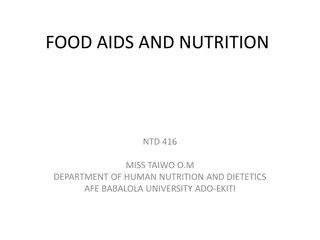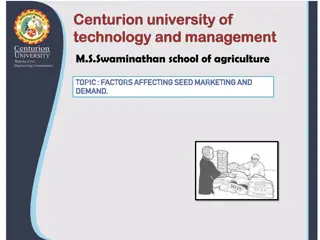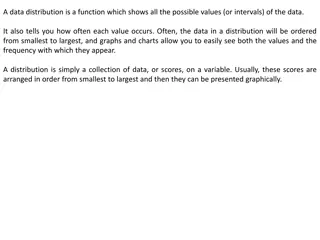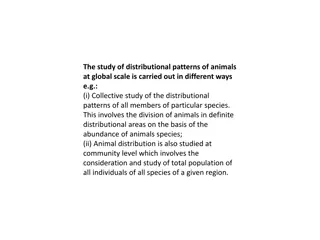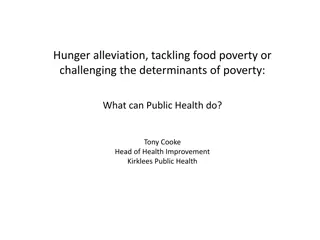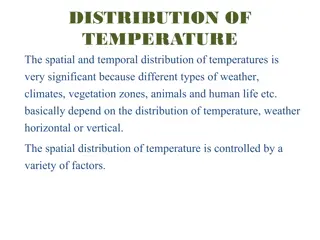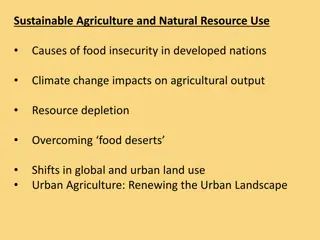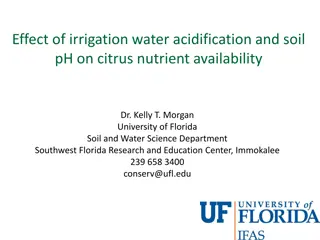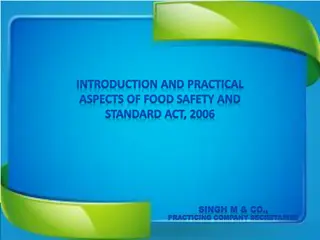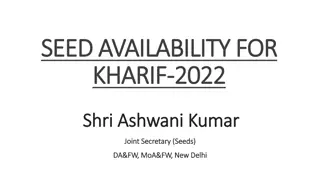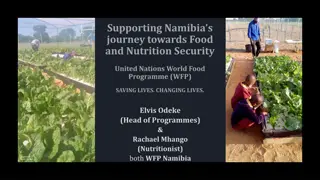Factors Affecting Food Availability and Distribution Worldwide
Factors like geography, climate change, economic determinants, and natural disasters significantly impact food availability globally. The varying production levels and suitability of regions for agriculture, coupled with issues like climate change-induced crop failures and economic constraints, lead to food shortages and reliance on imported foods. Religious and cultural beliefs also influence food practices within communities. Addressing these complex factors is crucial for enhancing global food security and ensuring equitable access to nutritious foods.
Download Presentation

Please find below an Image/Link to download the presentation.
The content on the website is provided AS IS for your information and personal use only. It may not be sold, licensed, or shared on other websites without obtaining consent from the author. Download presentation by click this link. If you encounter any issues during the download, it is possible that the publisher has removed the file from their server.
E N D
Presentation Transcript
MAHARSHI DAYANAND SARASWATI UNIVERSITY, AJMER TOPIC: FACTORS AFFECTING FOOD AVAILABILITY
Factors affecting food availability Many factors impact significantly on food availability and distribution, both locally and around the world. Each individual factor can disrupt supply or distribution chains; however, in situations where two or more factors affect food availability, the outcome can be devastating. Geography and Climate Enough food is produced in the world to feed everyone; however, the availability varies enormously. The amount of food produced in many developing countries is insufficient to feed the population, and they may experience severe food shortages.
Many areas around the world are unsuitable to produce crops. There can be many reasons for this and can inclide remote or inaccessible locations, mountainous countryside, poor soil for crops and also extreme weather. The countries that are unable to grow crops rely on imported foods and good transportation channels to supply the population's food needs. Worldwide climatic changes are likely to impact the global food security in many ways. Climate change is already bringing unpredictable weather patterns at unseasonable times. This damages crops. Higher temperatures and drier winters are melting the largest ice caps. Rising sea levels threaten to flood low-lying crops and can reduce the availability of safe drinking water.
Climate change is causing crops to not to grow which is leading countries to become more dependant on imported foods. With this comes political and economic consequences. Along with climate and weather, there are also natural disasters that can lead to food shortages. This occurs when mostly hit with flood or drought. Individuals and communities during this time are forced to rely on aid organisations to provide food aid. Drought is the most common natural cause and prime contributor to famine in arid and semiarid regions. The income families would have received from their crops would be cut off or reduced for and extended period of time
Economic determinants such as cost and income The cost of food and the ability of an individual to afford specific foods (related to income) are primary determinants of food choice. Low-income groups are reported to consume unbalanced diets and low intakes of fruit and vegetables. Increasing the amount of available income for food choices, however, does not necessarily mean that individuals will consume a more balanced and healthy diet. In addition, individuals may resist buying new foods for fear that the food made be wasted as the family may reject the food.
Religious Beliefs A community's religious and cultural beliefs often dictate many daily practices within the group. Cultures and religions link us to certain ideals and traditions. This regards the way one would live their life, the actions they performed and also the foods they ate. The cultural and religious beliefs of a group may also dictate what types of foods the people in that group can have. Cultural influences Cultural influences impact on diet choices and food preparation evidence has shown that traditions, beliefs and values are among the main factors influencing preference, mode of food preparation, and nutritional status. Cultural habits, however, have been shown to change, for example, when individuals move to a new country and adopt the food habits of the local culture.
Social class/socioeconomic factors There are differences in food choices in different social classes which lead to both under- and over-nutrition. For example, people within the higher social class groups tend to have healthier diets (e.g. higher intakes of fruit, lean meat, oily-fish, wholemeal products, and raw vegetables) compared with manual workers. It is thought that higher socioeconomic groups have healthier diets because they may have higher educational levels and may be more health conscious and have healthier lifestyles. Social class differences in diet are of particular concern with respect to health inequalities.
Social context Social context includes both the people who have an impact on an individual s eating behaviour and the setting in which an individual consumes their dietary choice. People influence an individual s food choices directly and indirectly: buying food on behalf of an individual is a direct impact whilst learning from a peer s behaviour (conscious or subconscious) has an indirect impact. Social support (e.g. families) can have a beneficial effect on individual s food choice by encouraging and supporting healthy eating practices. The setting for food consumption (e.g. home, school, work, and restaurants) will affect food choice by the availability of food options.




